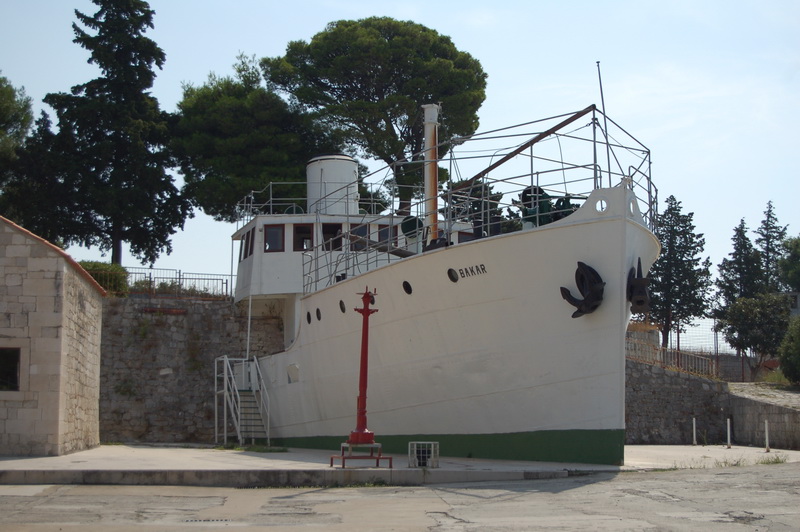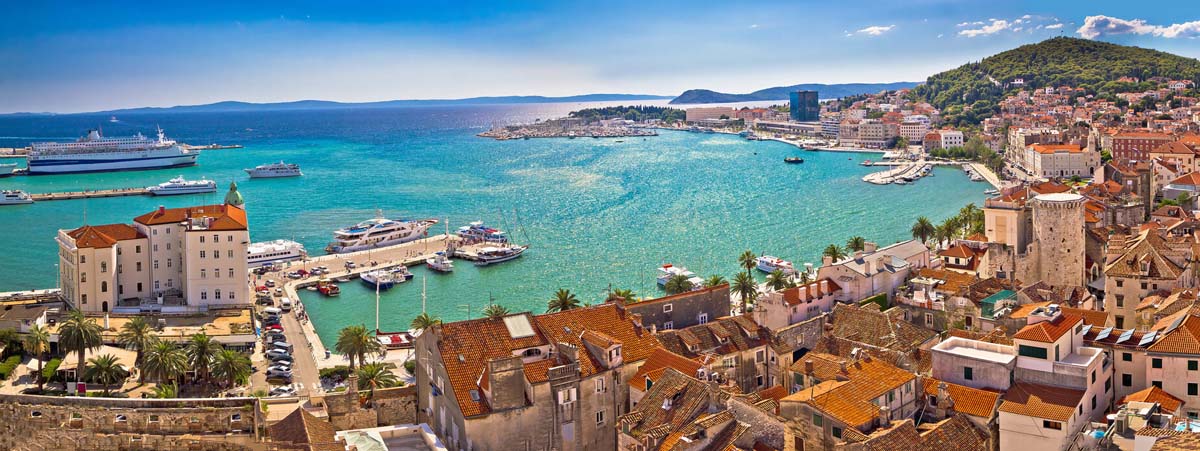
Split is the largest Dalmatian city and a major transportation hub with a huge port which sends ferries out to the Dalmatian islands and beyond . The first inhabitant of Split was the Roman emperor Diocletian who started to build his palace in this friendly bay around 293 AD. After his abdication he withdrew to this luxurious palace of about 30 thousand square meters.
The following turbulent centuries made the palace into a town first populated by the citizens of the nearby Salona, who fled before Avars and Slavs. The town overgrew the walls of the palace and its authorities kept changing - from Croatian kings in 10th century AD, Hungarian and Venetian administration, to French rulers and Austro-Hungarian monarchy.
Such past left its traces combined in the town everyday life. The city, however, went on remaining the centre of this part of the coast till our day. This mixture of historic layers brought some clumsiness and some things done too fast but today all that makes a part of its originality.
The big city today lives by the silent beats of history, lively spirit of the young and its particular Mediterranean charm.
THINGS TO SEE:
-
MAIN CITY SIGHTS
1. DIOCLETIAN PALACE

Facing the harbour, Diocletian’s Palace is one of the most imposing Roman ruins in existence and the place you’ll spend most of your time while in Split. Don’t expect a palace though, nor a museum – this is the living heart of the city, its labyrinthine streets packed with people, bars, shops and restaurants. The narrow streets hide passageways and courtyards, some deserted and eerie, others thumping with music from bars and cafes, while the local residents hang out their washing overhead, kids play football amid the ancient walls, and grannies sit in their windows watching the action below. It’s an enchanting place.
Although the original structure was modified in the Middle Ages, the alterations have only served to increase the allure of this fascinating site. The palace was built from lustrous white stone from the island of Brač, and construction lasted 10 years. Diocletian spared no expense, importing marble from Italy and Greece, and columns and sphinxes from Egypt. A military fortress, imperial residence and fortified town, the palace measures 215m from east to west (including the square corner towers) and is 181m wide at the southernmost point. The walls at their highest measure 26m and the entire structure covers 31,000 sq metres.
Each wall has a gate named after a metal: at the northern end is the Golden Gate , while the southern end has the Bronze Gate . The eastern gate is the Silver Gate and to the west is the Iron Gate . Between the eastern and western gates there’s a straight road (Krešimirova; also known as Decumanus), which separates the imperial residence on the southern side, with its state rooms and temples, from the northern side, once used by soldiers and servants. The Bronze Gate, in the southern wall, led from the living quarters to the sea. Two of the gates, the Bronze and the Golden, are fronted by city landmarks: Meštrović sculptures of literary scholar Marko Marulić and the medieval bishop Grgur Ninski.
There are 220 buildings within the palace boundaries, home to about 3000 people. Each street has small signs at its beginning and end marking what you’ll find upon it: bars, cafes, restaurants, shops, museums. It makes moving around much easier, though one of the best things you can do is get lost in the palace – it’s small enough that you’ll always find your way out easily. In any case, once you enter the palace, forget about street names.
The best way to see the palace’s main sights is to follow our walking tour.
2. CATHEDRAL OF St. DOMNIUS

Split’s cathedral was originally built as Diocletian’s mausoleum, with an octagonal form, encircled by 24 columns, that is almost completely preserved to this day. Its round domed interior has two rows of Corinthian columns and a frieze showing Emperor Diocletian and his wife, Prisca. The oldest monuments in the cathedral are the remarkable scenes from the life of Christ on the wooden entrance doors. Carved by Andrija Buvina in the 13th century, the scenes are presented in 28 squares, 14 on each side, and recall the fashion of Romanesque miniatures of the time.
Also notice the right altar carved by Bonino da Milano in 1427 and the vault above the altar decorated with murals by Dujam Vušković. To the left is the altar of St Anastasius (Sveti Staš; 1448) by Dalmatinac, with a relief of The Flagellation of Christ, which is one of the finest sculptural works of its time in Dalmatia.
The choir is furnished with 13th-century Romanesque seats that are the oldest in Dalmatia. Cross the altar and follow the signs to the treasury , rich in reliquaries, icons, church robes, illuminated manuscripts and documents in Glagolitic script. Part of the same structure, the Romanesque belfry was constructed between the 12th and 16th centuries and reconstructed in 1908 after it collapsed. Notice the two lion figures at the foot of the belfry and the Egyptian black-granite sphinx dating from the 15th century BC on the right wall. South of the mausoleum, there are remains of the Roman baths, a Roman building with a mosaic and the remains of the imperial dining hall, in various stages of preservation.
Note that admission to the cathedral also gets you free access to the Temple of Jupiter and its crypt. For 35KN, you can get a ticket that includes access to all these highlights.
The best way to see the St. Domnius church is to take one of our walking tour.
3. CROATIAN NATIONAL THEATRE

The story of Croatia’s National Theatre in Split is long and complicated but begins on December 26, 1859, right near the beginning of a period of autonomy in the city. Antonio Bajamonti was, during a brief respite from Venetian and Austro-Hungarian control, the city’s leader and a principal investor in the theatre that ultimately bore his name. Sadly, that theatre was almost completely destroyed in a fire in 1881 and plans to re-build on the original site were never realised. The theatre was relocated to its present location on (street) and has resided there since.
4. PROKURATIVE (TRG REPUBLIKE)

Trg Republike (Republic Square) is a large, open square surrounded on three sides by a collection of elaborate neo-Renaissance buildings known as the Prokurative. On the southern side, the square opens up to a lovely view of the harbour. Construction of the Prokurative started during the latter half of the 19th century under the supervision of General Marmont, with the buildings inspired largely by the architecture of the same period in Venice. While relatively unoccupied in the cooler months, the square comes alive in the summer with concerts and cultural events, the most popular being the Entertainment Musical Festival of Split.
5. RIVA

The Riva, a marble-white and palm-lined connection of Split and the Adriatic is everyone’s favorite spot for socializing, coffee-drinking or just idle sitting on one of the comfy benches which face the sea. Riva is full of life throughout the day, especially during the summer, and you’ll always find people strolling along or sitting in one of the cafes. So, if you want to get a feeling of the local everyday ”buzz” be sure to grab your spot and you’ll soon experience first hand how important and irresistible is the coffee culture in Croatia.
6. MARJAN HILL

For an afternoon away from the city buzz, Marjan (178m) is the perfect destination. Considered the lungs of the city, this hilly nature reserve offers trails through fragrant pine forests, scenic lookouts and ancient chapels . There are different ways of reaching Marjan. One is to to head up Plinarska street just behind the National Theatre, cross Nazorova street and continue west down Mandalinski Put until you get to the Northern Gate (Spinutska Vrata). Otherwise, you can start the walk closer to the centre, from the stairway (Marjanske Skale) in Varoš, right behind the Church of Sveti Frane. It’s a mild incline along old stone stairs and a scenic 10-minute trek to get to Vidilica cafe at the top. From here, right by the old Jewish cemetery, you can follow the marked trail, stopping en route to see the chapels, all the way to Kašjuni cove , a quieter beach option than buzzing Bačvice.
7. BACVICE BEACH

Bacvice are a neighborhood block in Split, as well as the name of a shallow, sandy beach because of which the part is so well-known. The cove of Bacvice is about 600m long, 180m of which is sandy, while the rest of the cove consists of a promenade. The Bacvice beach is a cult court on which the World Picigin Championship takes place every year.
8. GREEN MARKET

Any traveller worth their salt wants to get real and rub elbows with some of the locals and Split's Pazar is the place to go to satisfy that desire. Jump in and join in the hubbub going on, all dedicated to good ol' small scale market capitalism. The buying and selling frenzy involves a variety of wares such as fruits and veggies, clothing and other odds and ends.
9. MARMONTOVA STREET

The most beautiful street in Split was named by Napoleon's marshal Marmont who was responsible for the urbanisation of Dalmatian cities. A unique fish market decorates its centre, special because of the fact that you won't find flies there due to the smell of sulphur which can still be felt from the neighbouring spa. From the Riva to the top of Marmont street numerous shops line up from right to left, turning this street into one of the most important shopping oases' of the city centre. Witty contemporary fountain, called Pirja makes Marmontova street even more peculiar.
-
MUSEUMS AND GALLERIES
1. CITY MUSEUM

Built by Juraj Dalmatinac for one of the many noblemen who lived within the palace in the Middle Ages, Papalić Palace is considered a fine example of late Gothic style, with an elaborately carved entrance gate that proclaimed the importance of its original inhabitants. The interior has been thoroughly restored to house this museum. Captions are in Croatian, but wall panels in a variety of languages provide a historical framework for the exhibits. The museum has three floors, with drawings, heraldic coats of arms, 17th-century weaponry, fine furniture, coins and documents from as far back as the 14th century. You can see virtual tour of city museum HERE.
2. MEŠTROVIĆ GALLERY

At this stellar art museum, you’ll see a comprehensive, well-arranged collection of works by Ivan Meštrović, Croatia’s premier modern sculptor, who built the gallery as a personal residence from 1931 to 1939. Although Meštrović intended to retire here, he emigrated to the USA soon after WWII. Don’t miss the nearby Kaštelet , a fortress that Meštrović bought and restored to house his powerful Life of Christ wood reliefs. HERE.
3. GALLERY OF ART

Set close to palace's Golden gates, Gallery of art holds two thousand art pieces. It is museum of modern as well as conteporary arts.
4. ARCHAEOLOGICAL MUSEUM

Museum was founded in the year of 1820 and houses around 150 000 archaeological object dating from different history eras such as Roman, pre-historic era, Greek founding, underwater archaelogical objects...
5. ETHNOGRAPHIC MUSEUM

Founded in 1910, it was first located on National square, then was later moved to building right nex to Vestibul in Diocletian's palace. Every evening from 20.00h in the area in the from of museum, jazz music is played.
6. EMANUEL VIDOVIC GALLERY

Set right next to Silver gates of Dioletian's palace, this gallery started in 1986. when Emanuel Vidovic's work of art was bought from his successors. At first, the art pieces were waiting to be shown to public due to lack of free space in the city. Finally, they were housed in today's gallery space.
7. MARITIME MUSEUM

The Croatian Maritime Museum is situated in the courtyard of the Gripe Fortress and was founded in 1925.
The building represents a fine example of baroque bastion fortification and is of great historical importance. It is situated a short walk from the Roman city centre of Split, with magnificent views over the harbour.
8. NATURAL HISTORY MUSEUM

When founded in 1924, museum was located on Marjan hill along with the city zoo that had 41 animal species and 260 animals. As there was not enough funds to maintain the zoo and museum was getting to small for the collection, the building of museum of natural history was transferred to 1.156 m2 large space in building located on the east side of Green's market (Poljana kneza Trpimira 3).
9. MUSEUM OF CROATIAN ARCHAEOLOGICAL MONUMENTS

One of the oldest museums in Croatia, it houses around 20 000 objects. It was founded in 1863. in town of Knin, but in the fear of being destroyed in WW II, collection was first moved to Sinj, town near Split. Later, in 1978. it was officially re-opened in Split, Meje district.
10. SPLIT SPORT "HALL OF FAME"

The Hall of fame is a foundation to upcoming Museum of sport. Split is well-known for its athletes, as there were 151 athlete in Olympic games and 58 medal winners throughout the years.
It is located in Sport center "Gripe".
11. FOTO KLUB

Foto club in Split is located in Marmontova street and it is open almst every day with free entrance. Photography exhibitions are changing reguraly and it is a great place to visit while strolling through most famous street in Split.
-
PARKS AND NATURE
Besides Marjan hill, there are more green surfaces, parks and nature sights to see in Split, and here they are:
1. THE PENINSULA OF SUSTIPAN

The peninsula Sustipan is located west to the entrance to the port of Split. There was a city cemetery on the peninsula a while ago, which was allocated to another location after the Second World War. Sustipan was then transformed into a park. Besides the wonderful view of the nearby marina, you can see the relics of the Benedictine convent of St. Stjepan sub pinis in the park. According to the historic written sources, Croatian king Stjepan resided there. They say that when a man climbs on the cliffs of Sustipan and takes one look at the sea and sky, he feels a mysterious, mild current of the divine energy coming from the sky and the sea over himself.
2. PARK JOSIP JURAJ STROSSMAYER
.jpg)
Park Josip Juraj Strossmayer is central park in Split. It is also known under the name "Đardin" (dalmatian word for 'garden') and it is set right above palace's Golden gates. On the southeast corner of the park there is a memorial plaque for famous Croatian poet Tin Ujević, indicating the opening lines of his song 'Departure'.
3. EMANUEL VIDOVIĆ PARK

As he was one of the most imortant artists in Split history, there is another recognition for Emanuel Vidović in city. Park named after him is not lage, but it is one of the most visited by families with small children, as well as high school and college students. It is a perfect place for weekend relaxation and enjoyment.
4. ŽNJAN BEACH

Žnjan is one of the Split's districts and is located by the sea side. Long area next to sea is full with beautiful beaches, caffe bars and playgrounds for children. It is pedestrians only zone and it has seaside path that can take you all the to Bačvice beach in about 35 minutes walk.
5. MATEJUŠKA
Matejuška has been port for ships Split fishermen for centuries and even today there are dozens of tied boats, nets are drying...On Matejuška, there is a monument to the fishermen, a large hook. Matejuška is known for being the main spot for the young to hang out whenever it's warm in the evening, sitting by the sea, drinking beer and talking with friends.
-
CITY SQUARES
There are few more squares worth mentioning, other than Prokurative:
1. PERISTIL

Well-known square is set right in front of cathedral of St. Domnius and above the stairs that lead to palace cellars. To learn more about this beautiful place, take our Diocletian's Palace Tour.
2. VOĆNI TRG (FRUIT SQUARE)

Althought the official name of the square is Trg braće Radić (Radić brothers square), it is commonly know by Split's citizens as the Fruit square. The name origins from the time when women brought home-grown fruits here to sell it. Square is marked with the octagonal Venetian tower, the leftover of the former fortress, built in the 15th century and magnificent Palace of the old family Milesi from the 17th century with a spectacular Baroque facade. In the middle of it stands the monument to the father of the Croatian literature and citizen of Split, Marko Marulić (author of the monument, as well as of several others in the city is famous Ivan Meštrović).
3. NARODNI TRG (PEOPLE'S SQUARE)
You have probably realized that citizens of Split never use real names of the squares when they talk to each other. That notice taken, no need to second guess that People's square has a 'nickname'. Pjaca is first mentioned in 13th century and it was first inhabited area outside the Diocletian's palace. It was a home to many noblemen who built their residences around the square. The oldest bookstore in the world, Morpurgo, to this day looks almost the same as in 1861, and the tourism of Split begun with the former hotel Troccoli.
-
OTHER FASCINATING MONUMENTS WORTH VISITING:
PALACES & FORTRESS |
|
CHURCHES |
|





































